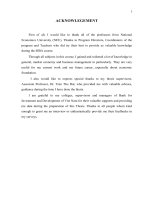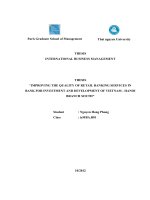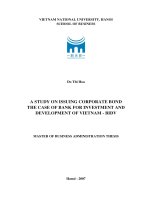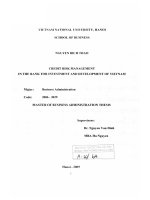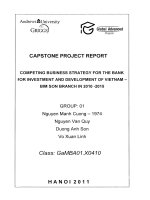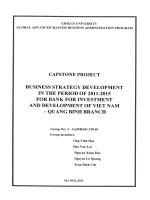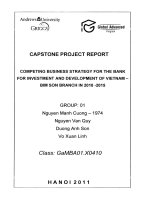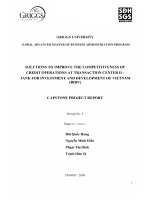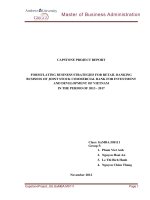A study on electronic banking the case of Bank for Investment and Development of Vietnam
Bạn đang xem bản rút gọn của tài liệu. Xem và tải ngay bản đầy đủ của tài liệu tại đây (37.23 MB, 121 trang )
VIETNAM NATIONAL UNIVERSITY, HANOI
SCHOOL OF BUSINESS
Nguyen Thi Tuyet Le
A STUDY ON ELECTRONIC BANKING
THE CASE OF BANK FOR INVESTMENT ANI)
DEVELOPMENT OF VIETNAM.
Major: Business Administration
Code: 60 34 05
A 'L O /
< s
MASTER OF BUSINESS ADMINISTRATION THESIS
Supervisors: Dr.Nguyen Viet Anh
Hanoi - 2010
TABLE OF CONTENTS
Acknowledgement i
Abstract ii
Tóm Tat iv
Table of Contents vi
List of Tables X!
List of Figures xii
INTRODUCTION
1. The problems
2. Objectives and Aims
3. Research questions
4. Scope of work
5. Data sources
6. M eth od s
7. Significance
8. Limitation
9. Expected results
10. Outline
CHAPTER 1
1.1. BASICS OF ELECTRONIC BANKING
1.1.1 Definition
I .I.I.I. Electronic C om m erce
I 1. 1.2. Electronic Finance
1 .1.1.3. Electronic Banking
1
1
9
?
2
3
3
3
3
4
4
5
5
5
5
6
7
1.1.2 The History of Klectronic Banking 9
1.2. FO RM S OF KLEC TRO NIC B A N K IN G 10
1.2.1. Electronic Banking using a telephone connection 10
12.1.1. Phone banking
11
12.1.2. Mobile banking
n
1.22. Electronic Banking usinu personal computers
15
P . 2.1. Hom ebanking
15
1 2.2.2. Internet bankint»
16
12.2.3. Mail banking
17
1.2 '. Others: Means of payment and self-service zones
17
12.3.1. Payment card
17
12.3.2. El I POS (Electronic fund transfer at point of sale)
18
12.3.3. ATMs (Automated Teller Machine)
18
12.3.4. Electronic wallet
19
12.3.5. Self-service zone
19
3. AD VA N T A G E S AND D ISA D V A N TAGE S OF 1
ELECTRONIC B A NK IN G
.20
1.1. The Benefits of Electronic Banking
70
1.3.1.1. Benefits to banking industry
?0
1.5.1.2. Benefits to customers
20
1.3.1.3. Economic benefits
22
1. .2. The Advantages of Electronic Banking
22
I 3. The Disadvantages of Electronic banking
23
4. EL ECT RONIC BA NKIN G R IS K S
74
1.‘. 1. Transaction/operations risk
24
I.‘.2. Credit risk
25
1.^.3. l iquidity, interest rate, price/market risks
26
1 4. Compliance legal risk 77
I/.5. Strategic risk
28
l.<6. Reputation risk
?9
viii
1.5. II Ỉ Cl RON IC BANKING STRATEGIC OPTIONS FOR BANKS
30
CHAPTER 2 35
2.1. ELECTRONIC BANKING IN VIETNAM
35
2.1.1. The development of Electronic Banking in Vietnam 35
2.1.2. Electronic Banking services in V ietn am 37
2.1.2 1. Home-banking 37
2 .1.2 2. Phone-banking 39
2.1.2 3. Mobile-banking 40
2.1.2 4. Internet-banking 40
2.1.2 5. Bank kiosk 41
2.2. OVERVIEW OF BIDV 41
2.2.1. Introduction of B ID V 4 i
2.2.2. Organization structure 43
2.2.3. Overview of business performance in the period 2005-2008 45
2.2 3.I. Business Performance 45
2.23.2. Services 46
2.3. TTE NECESSARY OF DEVELOPING ELECTRONIC BANKING IN BIDV
.
48
2.3.1. Trend in economic globalization 48
2.3.2. Competition pressure from banks 49
2.3.3. Income from E-Banking increases banks' revenu e 50
2.4. I ll STATUS QUOS OF ELECTRONIC BANKING IN BIDV 51
2.4.1. Electronic Banking using a telephone connection 52
BSNvi; - Banking Short M essage Service 52
2.4.2. Electronic Banking using personal com puters
55
2.4 2 H o m eban kin g 55
2.4 21. Internet banking: Direct Banking 58
2.4.3. Others: Means of payment and self-service zo nes 61
2.4 3 Pa\m ent card 61
2 .4.3.2. A T M s 64
2 .4.3.3. P O N 66
2.5. EVALUATION OF ELECTRONIC BANKING IN BIDV 69
2.5.1. Restrictions 70
2.5.2. Reasons for these restrictions 72
CHAPTER 3 77
3.1. POTENTIALS AND FUTURE PERSPECTIVES OF ELECTRONIC
BANKING IN VIETNAM 77
3.1.1. Stable economic environment and enormous growth o f bank s y ste m
77
3.1.2. Legal basis on co m p letion 80
3.1.3. Highly potential market with over 85 million people and higher level o f people's
knowledge, strong development o f internet services 81
3.1.4. The application o f information technology has achieved stages of developm ent 84
3.2. ORIENTATION AND STRATEGIC OPTIONS FOR DEVELOPING
ELECTRONIC BANKING IN BIDV 86
3.3. SOLUTIONS TO DEVELOP AND IMPROVE ELECTRONIC BANKING
SERVICES IN BIDV 91
3.3.1. Complete the information technology and build an internal information system,
promoting the development o f e-B an k in g 91
3.3.2. Risk management and privacy policy for e-banking custom ers 93
3.3.3. Frequent assessment and study o f customer segmentation and enhancement of
service quality, product & service diversification for e-banking cu s to m ers 95
3.3.4. Impulse to relationship with customers, establishment of contact center, and supply
of information and instruction in e-banking use to convince customers to stick at service
quality 96
3.3.5. Improvement of human resource quality
97
3.3.6. Improvement of the bank's financial pow er 100
3.3.7. Exploitation of retail services via the internet, the use o f card services, electronic
paym ent provided by commercial b an k s 101
3.3.8. Promotion of product m ark etin g 102
3.3.9. Other solutions 105
\
3.4. RECOMMENDATIONS 106
3.4.1. Recommendation for the G o v ern m en t 106
3.4.2. Recommendations for The State Bank o f Vietnam
107
3.4.3. Recom m endations for Vietnam Bank Association (VBA) 109
C O N CL U SIO N I 1 1
XI
LIST OF TABLES
Table 2.2: BSMS's business performance 2007-2008 54
I able 2.3: Home banking's business performance of BIDV 2007-2008
57
Table 2.4: Card service's business performance of BIDV 2007-2008
63
Table 3.1: Estimation of personal computer users in Vietnam 83
Table 2.1 : BIDV's business performance in the period 2005-2008
45
XII
LIST OF FIGURES
f igure 1.2: General trend in E-banking evolution 30
f igure 1.3: Strategic options for entering e-banking 32
f igure 1.4: Redefining the Primary Role of Bank Branches 34
Figure 2.1 : The organization structure of BIDV's Head Office
44
Figure 2.2: Before-tax Profit of BIDV from 2005 to 2008 46
Figure 2.3: Net Service Revenue in BIDV from 2005 to 2008
47
Figure 2.4: Interface of Directbanking serv ice
59
Figure 2.5: Cards’ market share of banks 63
f igure 2.6: ATM network in Vietnam
65
Figure 2.7: A I M 's market shares of banks 65
Figure 2.8: POS's market share of banks 68
Figure 3.1: Process of international economic integration in Vietnam
78
Figure 3.2: 1 he growth of numbers of card holders in Vietnam
80
Figure 3.3: Number of bank accounts by percentage of population and number of
Internet users in Vietnam by percentage of population 84
f igure 3.4: E-banking objectives of BIDV 87
Figure 3.5: BIDV's Strategic options for entering e-banking
90
Figure 3.6: Marketing strategy of e-banking 102
Figure 1.1 : Basic diagram of E-hanking 7
INTRODUCTION
1. The problems
I'-commerce has increased its significance during the iast decades and its
importance is still continuing to increase. Branches, which have had traditional means
of conducting business and interaction between parties have also been influenced by
the Internet and gone through many changes. One of these traditional branches is the
banking industry, which during the middle of the 1990‘s started offering banking
services over the Internet. The changes lead to that the physical interaction in the bank
office environment between the banks and their customers has diminished and been
replaced by customers conducting their errands from their homes and businesses. The
loss of interaction between the banks and their customers has evoked my interest in the
subject of developing e-banking services.
Electronic banking (e-banking) is the newest delivery channel for banking
services. The definition of e-banking varies among researches partially because
electronic banking refers to several types of services through which bank customers
can request information and carry out most retail banking services via computer,
television or mobile phone.
In recent years. Vietnam's commercial bank system has had strong changes in
bank's scale as well as service quality. Especially, some banks bravely experiment and
provide e-banking services for customers, bringing much convenience and
effectiveness for customers, banks and the economy. However, most customers still
reserv e and use restrict because the concept of e-banking is quite new and strange. Due
to many reasons (finance, technology, human resources ) some banks have no e-
banking services and/or e-banking is leaved open. Understanding the importance and
necessary of development of e-banking serv ices, BIDV quickly deployed these in past
years. Although, some results have been gained. BIDV is getting stuck of finding ways
develop and improve its e-banking services professionally.
The thesis "A study on electronic banking - The Case of Bank for Investment
and Dev elopment of Vietnam (BIDV)” aimed to study electronic banking and propose
solutions for improving and developing further e-banking serv ices in BIDV.
2. Objectives
The objectives of this thesis are to (a) review basic concept of electronic
banking, (b) Provide an overview of the potentials and future perspectives of e-banking
development in Vietnam, and the adoption of e-banking in BIDV, and analyze its
current e-banking serv ices to find out the problems of BIDV in adopting e-banking, (c)
propose solutions to improve and develop e-banking service in BIDV.
3. Research questions
I he complete list of research questions is as follows:
• What are definition, forms, benefits and risks of e-banking?
• What are the potentials and future perspectives of e-banking development in
Vietnam?
• What has BIDV's e-banking done so far and what are achieved results?
• What are problems of e-banking development in BIDV?
• What are solutions to improv e and develop e-banking services in BIDV?
4. Scope of work
lor the theoretical foundation, this thesis will study e-banking theories in the
world.
lor the ease study, this thesis will stud\ the adoption and development of e-
banking in BIDV. BIDV currently applies e-banking in the first step.
5. Data sources
lor the theoretical part, data sources are textbooks, articles from internet since
2004. As for the case stud\. data is obtained from interview with BIDV team and
internal data.
6. Methods
The thesis uses the empirical method, interview and case study in the study
process.
7. Significance
The thesis may contribute a small part to the development of e-banking sector,
which has been emerging in Vietnam. Since the forecast of internet booming in
Vietnam in next two or three years, many banks can implement the knowledge studied
in this thesis for their business activities.
8. Limitation
I he biggest limitation of this thesis is due to the freshness of internet services
industry in Vietnam in general, and e-banking in particular, therefore few academicals
reviews have been applied and proved. In case of the BIDV, it has just run for several
years and in the simple way. so it may be early to measure and judge exactly its
performance.
I lie other limit is from case study method. This method cannot cover all the
theoretical issues of e-banking. Thus, later this case, this thesis only studies several
areas in e-banking and applies some related key performance indicators to analyze
performance for BIDV.
9. Expected results
The thesis expects to give the systematical theory in electronic banking, find out
BIDV's e-banking performance restrictions and proposes solutions to improve it.
10. Outline
Excluding introduction, conclusion and reference part, this thesis includes three
parts as follows:
Chapter 1: Theoretical Foundation
Chapter 2: The Case of BIDV
Chapter 3: Solutions to improve and develop e-banking services in BIDV.
4
CHAPTER 1
THEORETICAL FOUNDATION
1.1. BASICS OF ELECTRONIC BANKING
1.1.1 Definition
1.1.1.1. Electronic Commerce
Electronic commerce (E-Commerce or EEC) is an emerging concept that
describes the process of buying and selling or exchanging of products, services, and
information v ia computer networks including the Internet. It is the use of the Internet
and the Web to transact business. 1 his means that e-commerce not only consists of
selling and purchasing of goods and services over the Internet, it also consists of
marketing, distributing and servicing products and services over the Internet. 1
Doing business online, typically via the Web. it is also called "e-business," "e-
tailing" and "1-commerce." Although in most cases e-commerce and e-business are
synonymous, e-commerce implies that goods and services can be purchased online,
w hereas e-business might be used as more of an umbrella term for a total presence on
the Web. which would naturally include e-commerce (shopping) component.
E-commerce may also refer to electronic data interchange (EDI), in which one
company's computer queries and transmits purchase orders to another company's
computer.
1 I urban. I., 2004: Preface
I {-commerce affects a great part of the world and has a huge impact on people
and business but also various professions.2 It is a growing industry: however, it took
almost 40 years until it was adopted by the market. By the end of 1990‘s e-commerce
was something that even, company wanted to be a part of. E-commerce was a success
for every business that joined the online family, but w ith the success came also failure.
Mam companies that were dedicated to the online business began to fail in the end of
1999 and this period was called the dotcom crash. Today there is a discussion about
why some companies failed in the end of 1999 and most scientists agree that the reason
for the dotcom crash was because many companies were not ready for online business.
Many businesses went online because of the great tales of fame and fortune that
circulated about e-commerce. Furthermore the technology was not ready yet for
handling the rapid expansion of e-commerce. Organizations that joined e-commerce
with specific, realistic and measurable goals and objectives avoided this failure online.3
I he future of e-commerce looks promising and profitable; almost every company
around (he world, weather small, medium or big. either has its own webpage or does
business online. Not only companies are frequent users of ecommerce but private
customers are also starting to use the Internet more and more to make their purchases
online.
1.1.1.2. Electronic Finance
E-finance can be defined as all which relates to the linking of business, finance,
and banking via electronic means, encompassing information gathering, processing,
retriev al, and transmission of data as well as the transmission, purchase, and selling of
goods and services.
‘ Turban. I ., 2004: Preface
' Trepper, C 2000: Introduction
But the definition broadens when we look at the new possibilities offered by
technology. Computers and the use of one time data entry and relational databases
mean that online real-time data about a company's business and accounts can be
generated, enabling managers to manage their companies in new and more proactive
ways.4
1.1.1.3. Electronic Banking
What is electronic banking?
E-Commerce
Conducting business through electronic networks
E-Finance
Providing financial services
through electronic ctonneis
E-Money
Stored value Of prepaid
payment mechanisms'
E-Banking
Providing banking products and
services through electronic
delivery channels
Internet banking
other linancial
services and
products
Insuronoe. online
brokering, etc
Telephone banking
Other electronic
delivery cnanneis
The đtter-É-n:* b«f*een e mcm-v and * taring
15 Item Y.'rth i-momy. bdlanws jrp not ten in
accounts •irt'i banic*
Figure 1.1: Basie diagram of e-banking
“Electronic banking is an umbrella term for the process by which a customer
may perform banking transactions electronically without visiting a brick-and-mortar
4 Andrew riuht. 2002: IM'inance
7
institution. I he following terms all refer to one form or another of electronic banking:
personal computer (PC) banking. Internet banking, virtual banking, online banking,
home banking, remote electronic banking, and phone banking. PC banking and Internet
or online banking is the most frequently used designations. It should be noted,
however, that the terms used to describe the various types of electronic banking are
often used interchangeably."
Electronic banking is the wave of the future. It provides enormous benefits to
consumers in terms of the ease and cost of transactions. But it also poses new
challenges for country’ authorities in regulating and supervising the financial system
and in designing and implementing macroeconomic policy.
Electronic banking has been around for some time in the form of automatic
teller machines and telephone transactions. More recently, it has been transformed by
the Internet, a new delivery channel for banking services that benefits both customers
and banks. Access is fast, convenient, and available around the clock, whatever the
customer's location. Plus, banks can provide services more efficiently and at
substantially lower costs.
Electronic banking also makes it easier for customers to compare banks' services
and products, can increase competition among banks, and allows banks to penetrate
new markets and thus expand their geographical reach. Some even see electronic
banking as an opportunity for countries with underdeveloped financial systems to
leapfrog developmental stages. Customers in such countries can access services more
easily from banks abroad and through wireless communication systems, which are
developing more rapidly than traditional "wired" communication networks.
The Hip side of this technological boom is that electronic banking is not only
susceptible to. but may exacerbate, some of the same risks—particularly governance,
legal, operational, and reputational inherent in traditional banking. In addition, it
poses new challenges. In response, many national regulators have already modified
their regulations to achieve their main objectives: ensuring the safety and soundness of
the domestic banking system, promoting market discipline, and protecting customer
rights and the public trust in the banking system. Policymakers are also becoming
increasingly aware of the greater potential impact of macroeconomic policy on capital
movements.
1.1.2 The History of Electronic Banking
Electronic innovation in banking can be traced back to the 1970s when the
computerization of financial institutions gained momentum (Pang, 1995). However, a
\isible presence of this was evident to the customers since 1981. with the introduction
of the automatic teller machine (ATM). Innovative banking has grown since then,
aided by technological developments in the telecommunications and Information
Technology industry. The early decade of the 1990s saw the emergence of automated
voice response (A\'R) technology. By using the AVR technology, banks could offer
telephone banking facilities for financial services. With further advancements in
technology, banks were able to offer services through personal computers owned and
operated by customers at their convenience, through the use of Intranet proprietary
softw are. The users of these services w ere, however, mainly corporate customers rather
than retail ones.5 The Security First Network Bank was the first Internet banking in
the world that was built in 1995. USA. After that some famous banks introduced their
Internet banking one after another, such as Citibank and Bank of America.
Soiail and Shanmugham, 2003.
9
1.2. FORMS OF ELECTRONIC BANKING
Making payments for goods and serv ices in cash or non-cash forms as well as
depositing money in financial institutions and managing these resources are an inherent
constituent of economic life. Banks serve as important intermediates. In recent years,
w ith the dev elopment of technologies and techniques, options for communication with
banks are expanding for clients. New services are originating such as home banking,
phone banking, internet banking and others.
Clients use modem communication media for remote communication with the
bank: a modem, telephone, computer or payment card. A characteristic feature of these
services is the client's uninterrupted round-the clock account access, i.e independent
of banking business hours and the ability to execute local and international payments
directly from the comfort of the home or office. This reduces cash handling and
transport costs, lowers the risk of theft or accepting counterfeit bank notes, increases
speed and enhances the comfort of making payments. Electronic communication means
are particularly coming to the forefront. These are more convenient, faster, and often
cheaper for clients. Banking experience shows it is suitable to use combinations of
several communication means, depending on individual segments, clients, and types of
operations, products and situations. Electronic banking is a service that specifically
uses electronic communication forms. Electronic banking can be divided on the basis
of the instruments used: telephone connection, personal computers, means of
payment /bank cards/ and self-service zones.
1.2.1. Electronic Banking using a telephone connection
Telephone banking and the first banking services using classic telephone lines
for communication date back to the turn of the sixties and sev enties of the last century.
These services grew very rapidly and at the close of the 20th century mobile phones
10
also started to be used in banking with the development of information and
communication technologies. In this period banks quickly responded to the dawning of
a new era in using mobile telephones world-wide and began communicating with their
clients by SMS messages, with GSM banking later becoming a natural component of
electronic banking. Each financial institution offers this under a different name, but the
essential product remains the same. A mobile phone can be used to communicate with
a so-called telephone banker or an automated telephone system, just as well as a fixed
line. However, opportunities for mobile phone usage in communication with a bank are
much greater. Mobile phone use represents a direct communication channel that spread
on a massive scale through which clients have immediate access to typing a bank
operation, ordering services or working with accounts. Electronic banking using a
telephone connection can be divided into phone banking (ATS. client advisor) and
mobile banking (SMS banking, GSM SIM Toolkit and WAP).
1.2.1.1. Phone banking
Phone banking is the provision of banking services using a classic telephone
line. A bank client can obtain the necessary information on dialing a telephone number
specified in advance. Before the requested banking service information is provided, the
client's identity is determined using contractually agreed terms. Using this banking
service enables bank clients to obtain information concerning active and passive
banking products, but a client can also actively use the bank payment system and
request, for example, a payment order or a collection order, open or cancel a term
deposit or a current account. In this case a fax connected to the telephone serves as an
output communication channel. The client advisor or so-called telephone banker is a
bank employee capable of providing any information about products and services and,
follow ing verification that he is speaking with an authorized person, can also perform
any passive or active operation. He can prov ide advice to the client and offer further
hanking products.
One advantage of this service is that it requires no additional technical
equipment apart from a telephone. As a rule bank telephone center (call center)
operators work 24 hours a day nonstop and it is thus possible to use their services from
am place at any time. A client advisor is a bank employee; the bank pays his salary
thus increasing its costs and fees for this serv ice. Banks therefore sometimes establish
automated telephone systems.
Automated Telephone System
The technical means necessary to use this system are the same as for
communication with a client advisor. A telephone is required, which must have tone
dialing 1 or be equipped with an accessory adaptor (tone dialer). An automated
telephone system works on the basis of a menu through which clients can move around
using buttons on the telephone. The service menu tree is usually designed to be simple
so that a choice does not take too long. More extensive information is sent to the client
by fax either to a telephone number agreed in advance or to a number requested by the
client. Cost efficiency is the advantage. Some banks offer this service to clients free-of-
charge because costs are negligible and comfort is significant. One disadvantage is that
problems can sometimes arise when the client cannot choose a menu item that
corresponds with his wishes or the computer responds to an instruction in a way that
differs from what the client wanted. It is then appropriate to connect to an automated
telephone system with a telephone banker who can resolve the problem.
1.2.1.2. M obile banking
SMS Ranking
SMS hanking uses short text messages sent through the client's mobile phone.
SMS text messages can be used for both passive and active operations similarly as with
classic telephone banking. A client can automatically receive information about his
account balance: an SMS is sent to the client immediately after a certain operation is
performed, or on request: a client sends the bank a correctly formatted message which
processes it and answers the client's request by SMS.
Information sent on request mostly concerns current interest rates or currency
exchange rates. Providing these is simple for the bank because this is publicly
accessible information that needs no protection. A client however can request
information about the balance in his account, which is not public information and must
be protected when it is provided. Passwords are used for this purpose or technologies
based on the principle of an electronic key. A client however is required to know the
code of every transaction including constant and variable symbols. The whole message
containing data separated by
# symbols sometimes has up to fifty characters. Users can
easily make mistakes. This is frequently a limiting factor for clients, reducing the
comfort factor in this service.
GSM SIM Toolkit
The (iSM SIM Toolkit service can only be used from a mobile phone
supporting (his technology. GSM SIM Toolkit is a software interface that enables
arbitrary changes to the mobile phone menu. Operators supporting this technology can
use it (o personalize mobile phone menus. This means that only functions activated and
paid for will appear on the user menu. This technology dates back to 1998. Among the
first companies to use it in banking applications based on the GSM SIM Toolkit
standard were RadioMobil and Hxpandia Bank in the Czech Republic. Most mobile
phones now on the market support for the (iSM SIM Toolkit. To use this service the
client needs to be using services of an operator supporting this standard in its network,
be a client of a bank that offers handling of accounts through the GSM SIM Toolkit,
have a mobile phone supporting GSM SIM Toolkit technology and use a special SIM
card for banking services.
After buying a special SIM card and activating it at the pertinent bank branch
the client can begin using this service. The mobile phone menu will be widened to
include the Banking Services item, through which it is possible to carry out active or
passive banking operations. The precise structure differs from one financial institution
to another. Security is what is important here. To access banking services it is
necessary to know BPUK (PUK for banking applications) and BPIN. BPUK is
assigned to a client by the bank when the application is activated and recorded on the
mobile phone's SIM card. BPIN is used for every access to protected items in the
banking application. When a client makes three unsuccessful attempts to type the
BPIN. access to the banking application and its items is blocked, it is necessary to
know the BPUK to unblock it. When the client fails ten times to type the right BPUK
the SIM card can no longer be used for banking services. The main advantage of this
service is its simplicity. A client just follows instructions on the mobile phone display.
WAP (Wireless Application Protocol)
WAP is often compared to web pages, although this is a simplification. Unlike
pages appearing on a computer monitor. WAP presents its output on a small mobile
phone display, therefore concentrating on text information. It is a form of gateway to
various services prepared by a mobile network operator or another firm. One condition
for using the service is that the client must have a mobile phone supporting WAP
technology. Security is again provided by an electronic key. WAP banking has not
caught on verv well so far. some hanks however continue to offer it despite the
relativ ely low number of users.
1.2.2. Electronic Banking using personal computers
Along with significant growth in the usage of mobile phones in banking
practice, personal computers have also come to the fore, which to an even greater
extent facilitate and modernize banking service provision. In an information society
this communication instrument plays an irreplaceable role and is indispensable for the
present day banking sphere. The area of electronic banking realized through personal
computers can be div ided into home banking, internet banking and mail-banking.
1.2.2.1. Home banking
I lome banking is a serv ice that enables a bank client to handle his accounts from
a computer from a place selected in advance, at home or in the office. The main
features of home banking systems are the high level of security, comfort, simplicity of
use. openness of the system, wide communication possibilities, networking, definition
of users and their rights, automated data transmission and the option to define a
combined signature specimen.
A home banking system usually consists of two parts: a bank computer program
and a program in the client's computer. The bank program works as a communication
server. It receives calls from clients, verifies their identity, receives data from them,
authenticates digital signatures, generates digital receipts and sends data to clients. A
home banking computer system is a multi user application, meaning that several of the
client's employees can work with it. in particular:
a) Administrator - can define new employees, change rights.
b) Sender ensures communication w ith the bank and transmission of prepared data.
e) Accountant can type payment orders and orders lor collection,
b) Viewer - can browse through statements and announcements received.
This system is open and can be expanded in the future without great cost.
1.2.2.2. Internet banking
Internet banking can be used from the home or the office, as well as an internet
café. although the latter is not recommended for security reasons. In order to handle his
account a user just needs an internet browser (such as MS Explorer or Netscape
Navigator). A client cannot avoid visiting the bank though, because he must first ask
for an identification code. After opening the bank's web site the client simply selects
internet banking and. further to proper identification, can perform passive or active
operations. Good internet banking should provide a maximum of services. No less
important are the graphic interface, clarity, simplicity, and unambiguity of usage. The
intelligibility of texts determines simplicity and speed of understanding of the meaning
of menu items, data fields, and general text information displayed to the client.
Safety for concrete applications is assured by client authentication, verification
of data and data protection by encryption. Client identification is done using passwords
or codes. The client chooses some of these and the bank assigns others. It is
recommended to choose a password made up of various types of characters, which can
be a combination of numbers, low er case and capital letters, and special symbols.
Banks usually protect large volume transactions with additional security means,
such as an encryption (authentication) calculator, or a token, which generates
nonrecurring random passwords, which a client types on confirming an order. The
token itself is protected by certain security features. Work with it is only enabled after
the client types a four-digit PIN code, whereby the user can change the PIN at any
time. In the event of three failed attempts to type the correct PIN the token blocks
itself. After 60 seconds of inactivity a token automatically switches itself off and once
switched hack on. it again requests the PIN.
When a client generates several authentication codes in succession and types
none of them into the client system, the key becomes desynchronized. This protection
serves to prevent use of the key for other purposes. A cheaper and. based on its
dimensions, more practical alternative to a token is a grid card. This is a card with a
mesh drawn on it with fields with random generated characters. The user authorizes an
activ e operation by typing the right code from the field of the card the operator requests
from him.
1.2.2.3. M ail banking
Mail banking is another electronic banking service that makes it possible to
communicate with the bank by electronic mail or e-mail. The most frequently used
serv ice is sending account statements at agreed periodicity to the client's mailbox. E-
mail is not used for more complex operations.
1.2.3. Others: Means of payment and self-service zones
Apart from those already mentioned, there are other more or less widely known
forms of electronic banking, including a payment card, an electronic wallet and a self-
service zone.
1.2.3.1. Payment card
A payment card is currently one of the most widely used payment instruments
designated for authorized holders through which they can perform non-cash payments
or cash w ithdrawals from an extensiv e network of automated teller machines.
17
/ 1 , Lo / 6 6
